Three-Dimensional Modeling of the Xichang Crust in Sichuan, China by Machine Learning
Abstract
:1. Introduction
2. Data and Methods
2.1. Data
2.1.1. Seismotectonic Setting
2.1.2. Earthquake Catalogue
2.2. Methods
3. Velocity Structure Model
4. Morphology of Active Fault
4.1. Initial Fault Model
4.2. The Geometric Features of Fault Plane
5. Seismotectonic Structure
5.1. DBSCAN
5.2. Seismic Energy Cluster
5.3. Density Calculation and Isosurface Extraction
6. Crustal Medium Structure
7. Discussions and Conclusions
7.1. Discussion
7.2. Conclusions
Author Contributions
Funding
Informed Consent Statement
Data Availability Statement
Acknowledgments
Conflicts of Interest
References
- Yao, H. Building the community velocity model in the Sichuan-Yunnan region, China: Strategies and progresses. Sci. China Earth Sci. 2020, 63, 1425–1428. [Google Scholar] [CrossRef]
- Jiang, C.S.; Fang, L.H.; Han, L.B.; Wang, W.L.; Guo, L.J. Assessment of earthquake detection capability for the seismic array: A case study of the Xichang seismic array. Chin. J. Geophys. 2015, 58, 832–843. (In Chinese) [Google Scholar]
- He, H.-L.; Yasutakyr, I. Faulting on The Anninghe Fault Zone, Southwest China in Late Quaternary and Its Movement Model. Acta Seismol. Sinica 2017, 29, 537–548. (In Chinese) [Google Scholar] [CrossRef]
- Lu, R.Q. The fault model in China Seismic Experimental Site. In China Seismic Experimental Site; Springer: Singapore, 2019. [Google Scholar] [CrossRef]
- Lu, R.Q.; Liu, Y.D.; Xu, X.W.; Tan, X.B.; He, D.F.; Yu, G.H.; Cai, M.G.; Wu, X.Y. Three-Dimensional Model of the Lithospheric Structure Under the Eastern Tibetan Plateau: Implications for the Active Tectonics Seismic Hazards. Tectonics 2019, 38, 1292–1307. [Google Scholar] [CrossRef]
- Yi, G.X.; Long, F.; Zhao, M.; Gong, Y.; Qiao, H.Z. Focal Mechanism and Seismogenic Structure of The M5.0 Yuexi Earthquake On 1 Oct. 2014, South Western China. Seismol. Geol. 2016, 38, 1124–1136. (In Chinese) [Google Scholar]
- Li, J.; Wang, Q.C.; Cui, Z.J.; Zhang, P.; Zhou, L.; Zhou, H. Characteristics of Focal Mechanisms and Stress Field in the Eastern Boundary of Sichuan-Yunnan Block and Its Adjacent Area. Seismol. Geol. 2019, 41, 1395–1412. (In Chinese) [Google Scholar]
- Zhou, L.Q.; Xia, J.Y.; Shen, W.S.; Zheng, Y.; Yang, Y.J.; Shi, H.X.; Ritzwoller, M.H. The structure of the crust and uppermost mantle beneath South China from ambient noise and earthquake tomography. Geophys. J. Int. 2012, 189, 1565–1583. [Google Scholar]
- Yang, Y.; Ritzwoller, M.H.; Zheng, Y.; Shen, W.S.; Levshin, A.L.; Xie, Z.J. A synoptic view of the distribution and connectivity of the mid-crustal low velocity zone beneath Tibet. J. Geophys. Res. 2012, 117, B04303. [Google Scholar] [CrossRef]
- Zhao, L.F.; Xie, X.B.; He, J.K.; Tian, X.; Yao, Z.X. Crustal flow pattern beneath the Tibetan Plateau constrained by regional Lg-wave Q tomography. Earth Planet Sci. Lett. 2013, 383, 113–122. [Google Scholar] [CrossRef]
- Wei, W.; Zhao, D.; Xu, J.; Zhou, B.; Shi, Y. Depth variations of P-wave azimuthal anisotropy beneath Mainland China. Sci. Rep. 2016, 6, 29614. [Google Scholar] [CrossRef] [Green Version]
- Shen, W.; Ritzwoller, M.H.; Kang, D.; Kim, Y.H.; Lin, F.C.; Ning, J.; Wang, W.; Zheng, Y.; Zhou, L. A seismic reference model for the crust and uppermost mantle beneath China from surface wave dispersion. Geophys. J. Int. 2016, 206, 954–979. [Google Scholar] [CrossRef] [Green Version]
- Tan, X.L.; Fang, L.H.; Wang, W.L.; Wu, J.P. Rayleigh Wave Group Velocity Tomography with Ambient Noise in the Anninghe-Zemuhe FaultZone and Its Surrounding Areas. Earthq. Res. China 2018, 34, 400–413. (In Chinese) [Google Scholar]
- Xin, H.; Zhang, H.; Kang, M.; He, R.; Gao, L.; Gao, J. High resolution lithospheric velocity structure of continental China by double-difference seismic travel-time tomography. Seismol. Res. Lett. 2019, 90, 229–241. [Google Scholar] [CrossRef]
- Liu, Y.; Yao, H.J.; Zhang, H.H.; Fang, H. The Community Velocity Model, V.1.0 of Southwest China, Constructed from Joint Body- and Surface-Wave Travel-Time Tomography. Seismol. Res. Lett. 2021, 92, 2972–2987. [Google Scholar] [CrossRef]
- Han, S.; Zhang, H.; Xin, H.; Shen, W.; Yao, H. USTClitho2.0: Updated Unified Seismic Tomography Models for Continental China Lithosphere from Joint Inversion of Body-Wave Arrival Times and Surface Wave Dispersion Data. Seismol. Res. Lett. 2022, 93, 201–215. [Google Scholar] [CrossRef]
- Shang, Y.J.; Yang, C.G.; Jin, W.J.; Chen, Y.W.; Hasan, M.; Wang, Y.; Li, K.; Lin, D.M.; Zhou, M. Application of Integrated Geophysical Methods for Site Suitability of Research Infrastructures (RIs) in China. Appl. Sci. 2021, 11, 8666. [Google Scholar] [CrossRef]
- Zhang, Z.; Zhang, H.; Wang, L.S.; Cheng, H.H.; Shi, Y.L. Late Cenozoic structural deformation and evolution of the central-southern Longmen Shan fold-and-thrust belt, China: Insights from numerical simulations. J. Asian Earth Sci. 2019, 176, 88–104. [Google Scholar] [CrossRef]
- Zhang, H.; Wu, Z.L.; Zhang, D.L.; Liu, J.; Wang, H.; Yan, Z.Z.; Shi, Y.L. Virtual Sichuan-Yunnan—Design and construction of regional strong earthquake evolution numerical model based on ten million mesh parallel finite element calculation. Sci. China Earth Sci. 2009, 39, 260. [Google Scholar] [CrossRef]
- Kong, Q.; Trugman, D.T.; Ross, Z.E.; Bianco, M.J.; Meade, B.J.; Gerstoft, P. Machine Learning in Seismology: Turning Data into Insights. Seismol. Res. Lett. 2019, 90, 3–14. [Google Scholar] [CrossRef] [Green Version]
- Bergen, K.J.; Johnson, P.A.; Maarten, V.; Beroza, G.C. Machine learning for data-driven discovery in solid Earth geoscience. Science 2019, 363, eaau0323. [Google Scholar] [CrossRef]
- Joshi, A.; Kaur, R. A review: Comparative study of various clustering techniques in data mining. Int. Adv. Res. Comp. Sci. Softw. Eng. 2015, 1, 1–4. [Google Scholar]
- Trugman, D.T.; Shearer, P.M. GrowClust: A hierarchical clustering algorithm for relative earthquake relocation, with application to the Spanish Springs and Sheldon, Nevada, earthquake sequences. Seismol. Res. Lett. 2017, 88, 379–391. [Google Scholar] [CrossRef]
- Kuang, W.; Yuan, C.; Zhang, J. Real-time determination of earthquake focal mechanism via deep learning. Nat. Commun. 2021, 12, 1432. [Google Scholar] [CrossRef]
- Yin, J.; Li, Z.; Denolle, M. Source time function clustering reveals patterns in earthquake dynamics. Seismol. Res. Lett. 2021, 92, 2343–2353. [Google Scholar] [CrossRef]
- Ansari, A.; Firuzi, E.; Etemadsaeed, L. Delineation of Seismic Sources in Probabilistic Seismic-Hazard Analysis Using Fuzzy Cluster Analysis and Monte Carlo Simulation. Bull. Seismol. Soc. Am. 2015, 105, 2174–2191. [Google Scholar] [CrossRef]
- Ester, M.; Kriegel, H.P.; Sander, J.; Xu, X. A density-based algorithm for discovering clusters in large spatial databases with noise. In Proceedings of the Second International Conference on Knowledge and Data Mining, AAAI Press 96, Portland, OR, USA, 2–4 August 1996; pp. 226–231. [Google Scholar]
- Ouillon, G.; Sornette, D. Segmentation of fault networks determined from spatial clustering of earthquakes. J. Geophys. Res. Solid Earth 2011, 116, B02306. [Google Scholar] [CrossRef] [Green Version]
- Wang, Y.; Ouillon, G.; Woessner, J.; Sornette, D.; Husen, S. Automatic reconstruction of fault networks from seismicity catalogs including location uncertainty. J. Geophys. Res. Solid Earth 2013, 118, 5956–5975. [Google Scholar] [CrossRef] [Green Version]
- Kaven, J.O.; Pollard, D.D. Geometry of crustal faults: Identification from seismicity and implications for slip and stress transfer models. J. Geophys. Res. Solid Earth 2013, 118, 5058–5070. [Google Scholar] [CrossRef]
- Brunsvik, B.; Morra, G.; Cambiotti, G.; Yuen, D.A. Three-dimensional paganica fault morphology obtained from hypocenter clustering (L’Aquila 2009 seismic sequence, Central Italy). Tectonophysics 2021, 804, 228756. [Google Scholar] [CrossRef]
- Cong, B.L.; Zhao, D.S.; Zhang, W.H.; Zhang, Z.Z.; Yang, M. Characteristics of Magmatic Activity in the Sichang Area and Its Bearing on the Tectonic Geological Development. Sci. Geol. Sin. 1973, 8, 175–195. (In Chinese) [Google Scholar]
- Liu, F.H. Characteristics of geological structure and seismicity in Xichang area. J. Chengdu Inst. Geol. 1982, 23–28. (In Chinese) [Google Scholar]
- He, H.L.; Ikeda, Y.; He, Y.L.; Togo, M.; Chen, J.; Chen, C.; Tajikara, M.; Echigo, T.; Okada, S. Newly-generated Daliangshan Fault zone-Shortcutting on the central section of Xianshuihe-Xiaojiang Fault system. Sci. China Ser. D Earth Sci. 2008, 51, 1248–1258. [Google Scholar] [CrossRef]
- Wen, X.Z. Character of rupture segmentation of the Xianshuihe-Anninghe-Zemuhe fault zone, western Sichuan. Seismol. Geol. 2000, 22, 239–249. [Google Scholar]
- Cheng, J.; Liu, J.; Xu, X.W.; Gan, W.J. Tectonic Characteristics of Strong Earthquakes in Daliangshan Sub-Block and Impact of the MS6.5 Ludian Earthquake in 2014 on the Surrounding Faults. Seismol. Geol. 2014, 36, 1228–1243. (In Chinese) [Google Scholar]
- Hu, Y.X.; Zeng, Z.; Li, C.J.; Li, Y.H.; Song, S.W. Research on Present-day Crustal Deformation and Fault Activities in Xichang Area. Earthquake 2020, 40, 62–72. (In Chinese) [Google Scholar]
- Sun, H.Y.; He, H.L.; Wei, Z.Y.; Gao, W. Late Quaternary Activity of Zhuma Fault on the North Segment of Daliangshan Fault Zone. Seismol. Geol. 2015, 37, 440–454. (In Chinese) [Google Scholar]
- Wei, Z.Y.; He, H.L.; Shi, F.; Xu, Y.R.; Sun, H.Y. Slip Rate on the South Segment of Daliangshan Fault Zone. Seismol. Geol. 2012, 34, 282–293. (In Chinese) [Google Scholar]
- He, M.X.; Fang, H.; Wang, X.B.; Jing-Qi, L.U.; Yuan, Y.Z.; Bai, D.W.; Bing-Rui, D.U.; Qiu, G.G.; Gao, B.T. Deep Conductivity Characteristics of The Southern Xianshuihe Fault Zone. Chin. J. Geophys. 2017, 60, 2414–2424. (In Chinese) [Google Scholar] [CrossRef]
- Li, D.H.; Ding, Z.F.; Wu, P.P.; Liang, M.; Gu, Q.P. Deep structure of the Zhaotong and Lianfeng fault zones in the eastern segment of the Sichuan-Yunnan border and the 2014 Ludian MS6.5 earthquake. Chin. J. Geophys. 2019, 62, 4571–4587. (In Chinese) [Google Scholar] [CrossRef]
- Si, Z.Y.; Jiang, C.S. Research on Parameter Calculation for the Ogata–Katsura 1993 Model in Terms of the Frequency–Magnitude Distribution Based on a Data-Driven Approach. Seismol. Res. Lett. 2019, 90, 1318–1329. [Google Scholar] [CrossRef]
- Grada, M.; Polkowskia, M.; Ostaficzukb, S.R. High-resolution 3D seismic model of the crustal and uppermost mantle structure in Poland. Tectonophysics 2016, 666, 188–210. [Google Scholar] [CrossRef]
- Moschetti, M.P.; Ritzwoller, M.H.; Lin, F.C. Seismic evidence for widespread crustal deformation caused by extension in the western USA. Nature 2010, 464, 885–889. [Google Scholar] [CrossRef]
- Mos5chetti, M.P.; Ritzwoller, M.H.; Lin, F.C.; Yang, Y. Crustal shear velocity structure of the western US inferred from amient noise and earthquake data. Geophys. Res. 2010, 115, B007448. [Google Scholar] [CrossRef]
- Manu-Marfo, D.; Aoudia, A.; Pachhai, S.; Kherchouche, R. 3D shear wave velocity model of the crust and uppermost mantle beneath the Tyrrhenian basin and margins. Sci. Rep. 2019, 9, 3609. [Google Scholar] [CrossRef]
- Qiu, Q.; Hill, E.M.; Barbot, S.; Hubbard, J.; Feng, W.; Lindsey, E.O.; Tapponnier, P. The mechanism of partial rupture of a locked megathrust: The role of fault morphology. Geology 2016, 44, 875–878. [Google Scholar] [CrossRef]
- Lohr, T.; Krawczyk, C.M.; Oncken, O.; Tanner, D.C. Evolution of a fault surface from 3D attribute analysis and displacement measurements. J. Struct. Geol. 2008, 30, 690–700. [Google Scholar] [CrossRef] [Green Version]
- Røe, P.; Georgsen, F.; Abrahamsen, P. An uncertainty model for fault shape and location. Math. Geosci. 2014, 46, 957–969. [Google Scholar] [CrossRef] [Green Version]
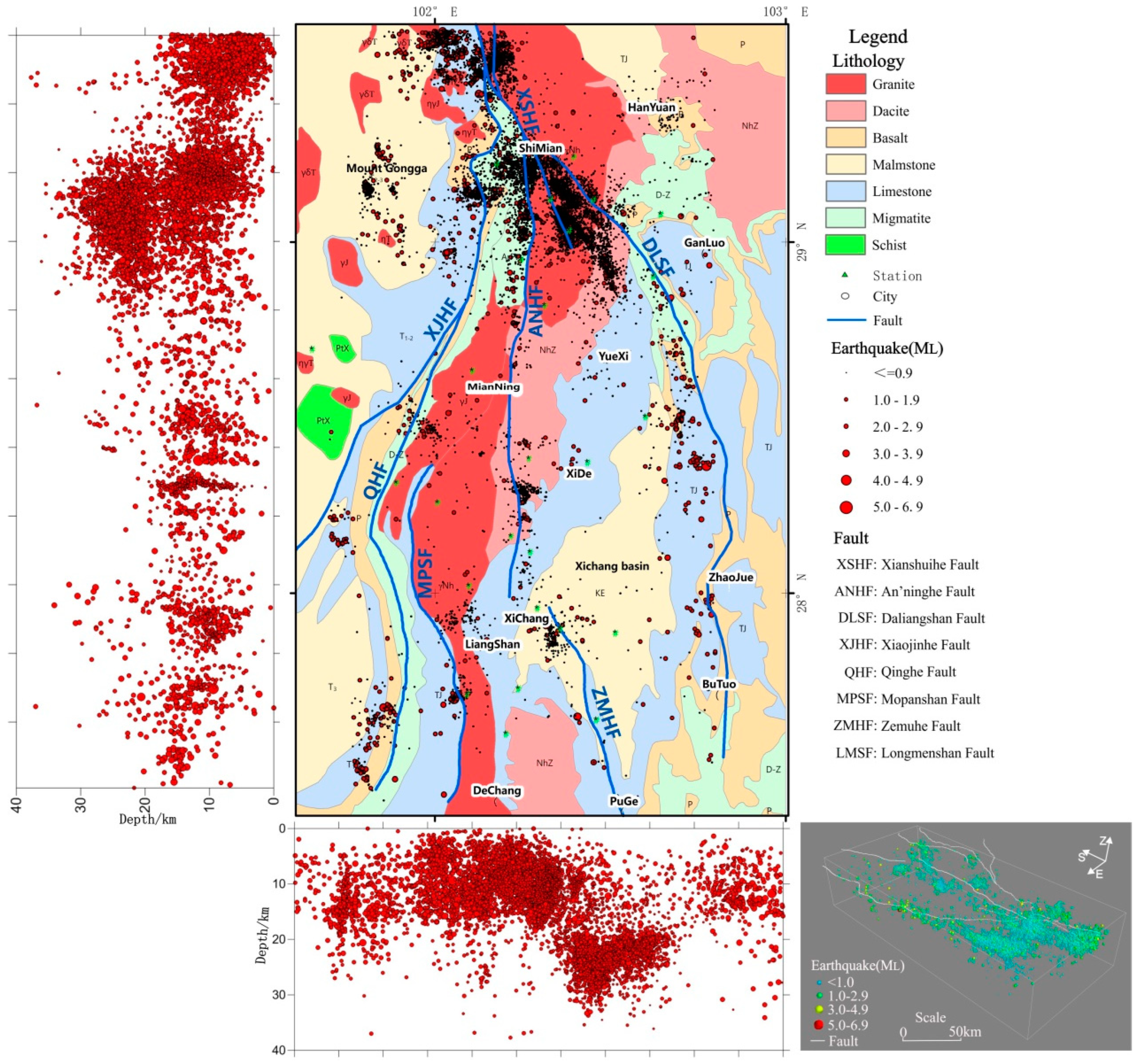
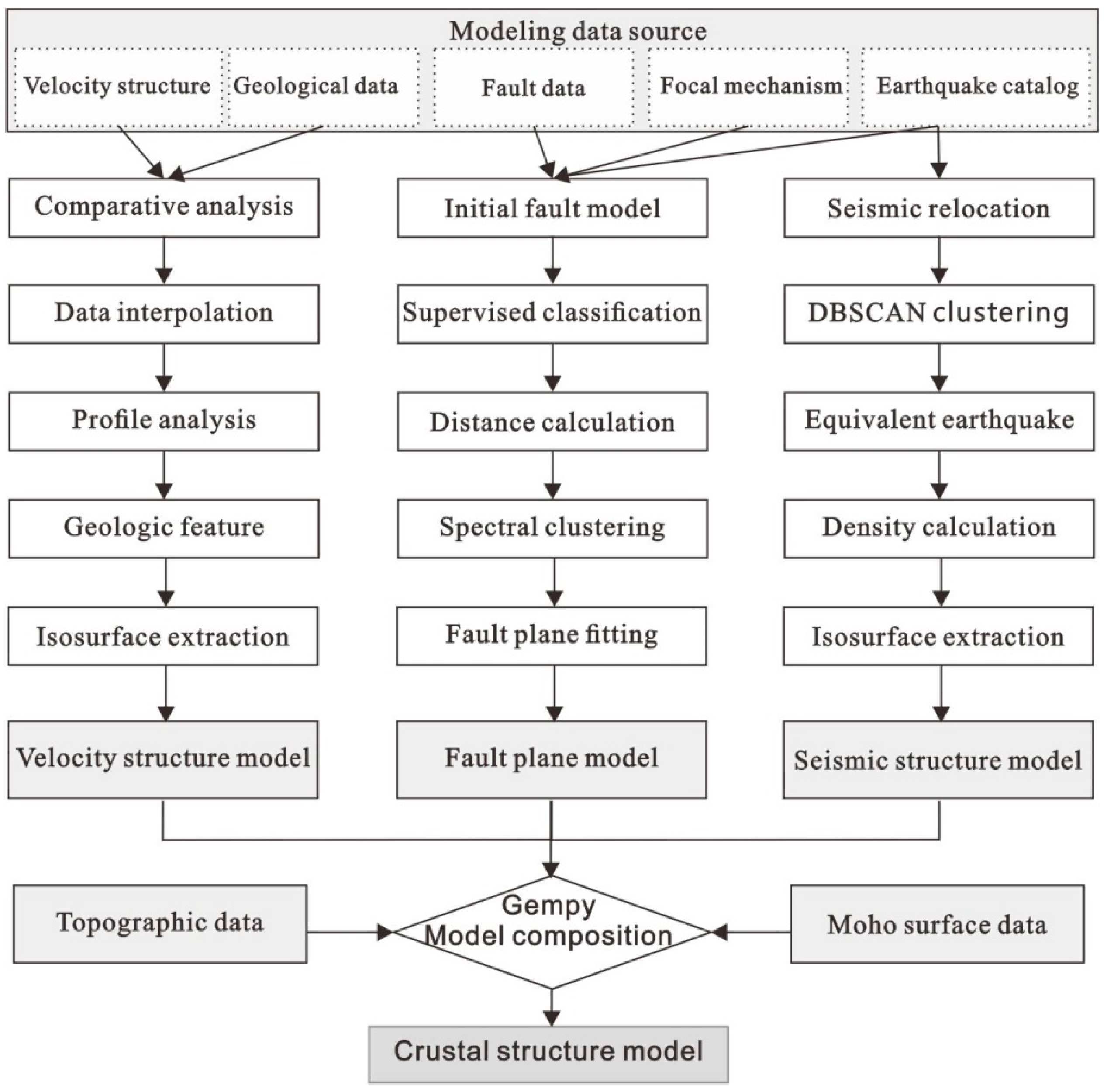
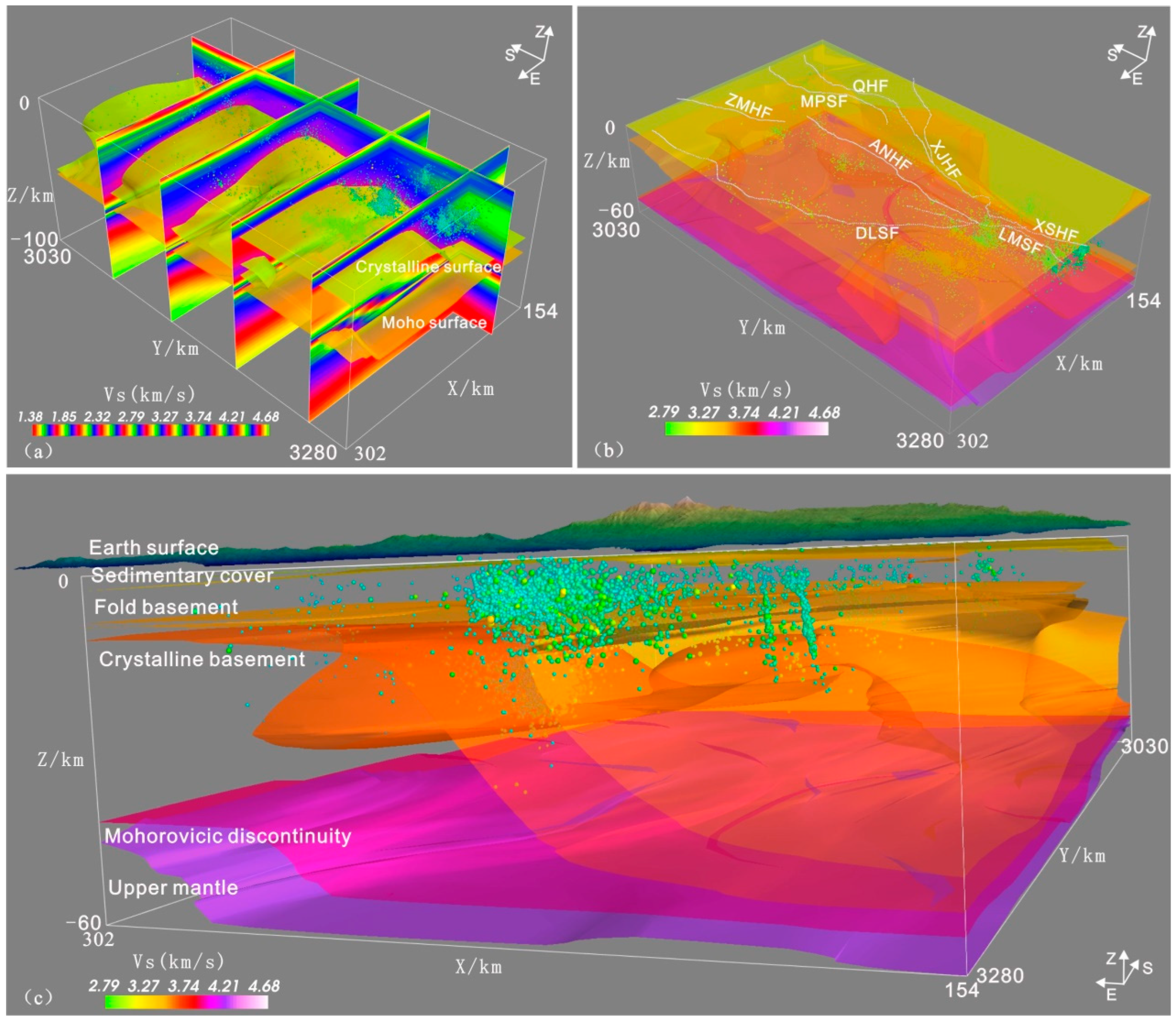
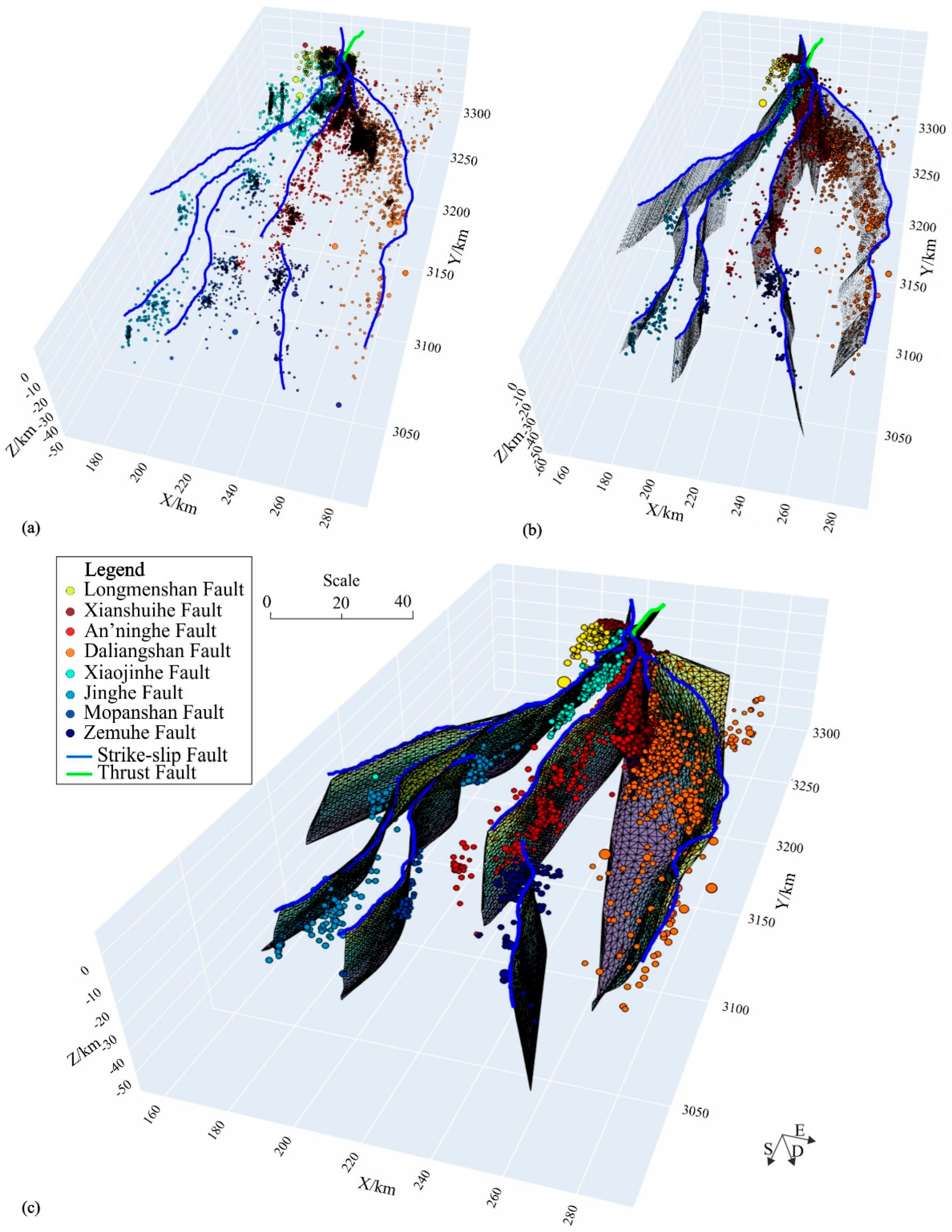
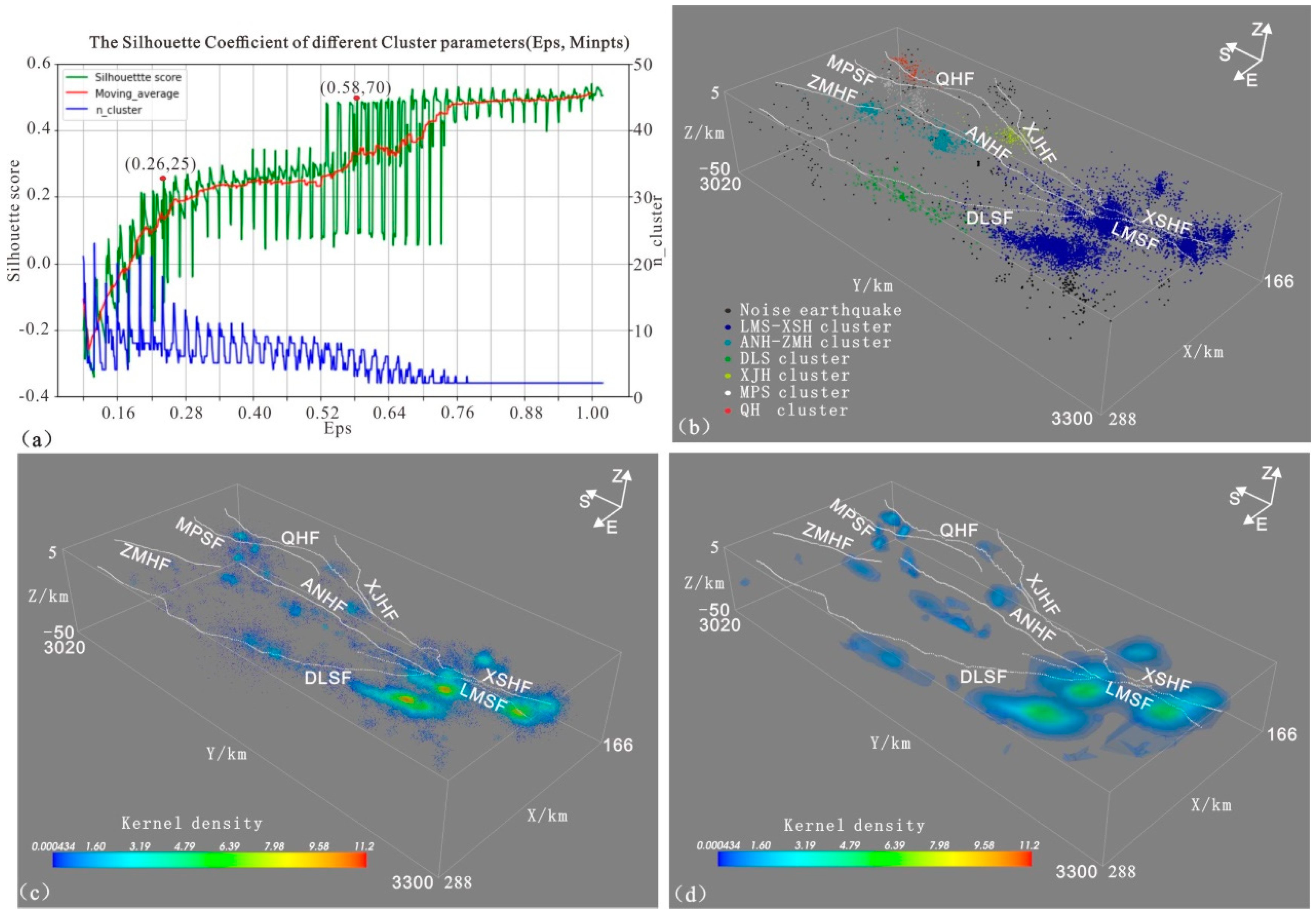
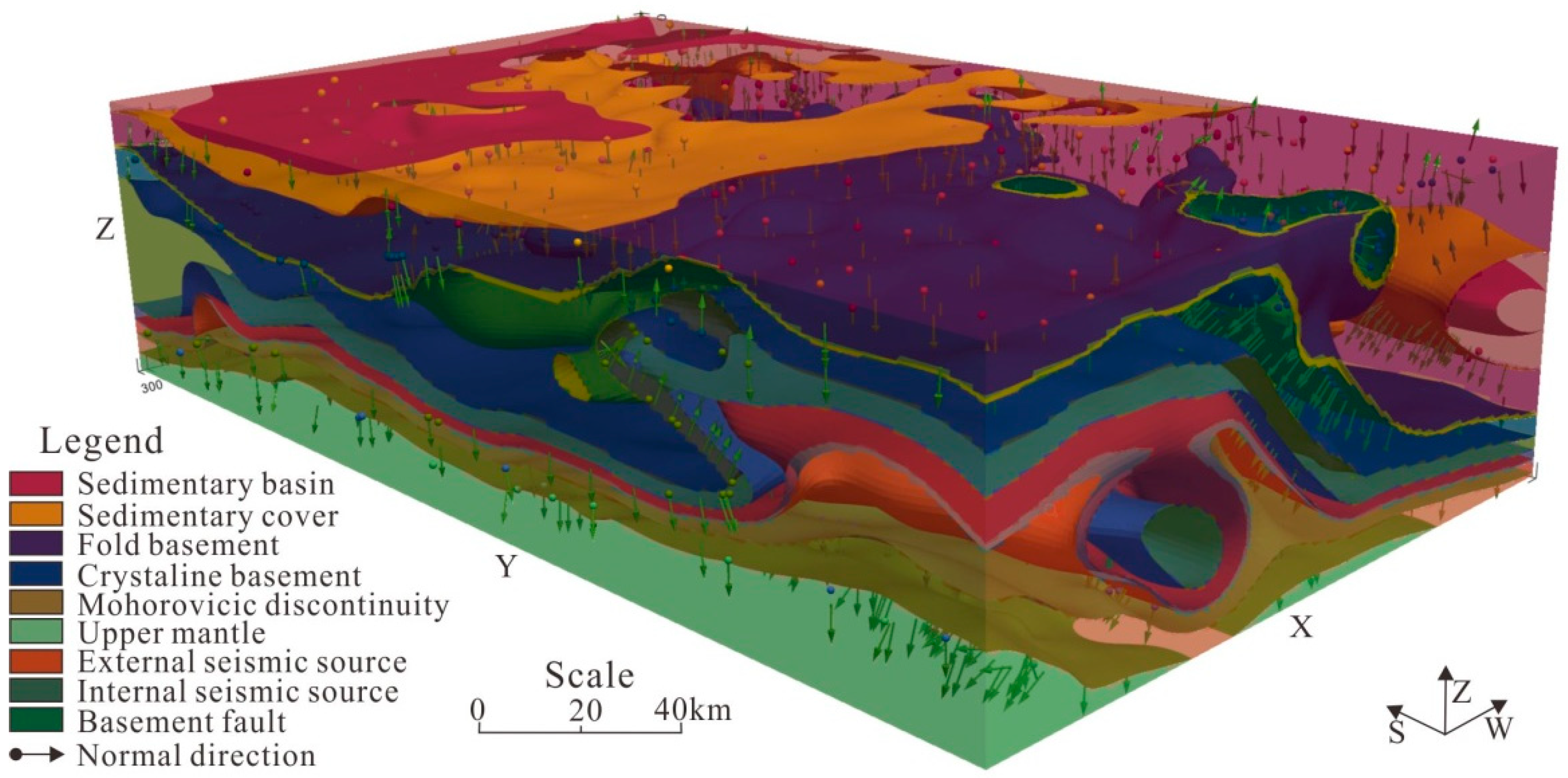
| Regional Model | Inversion Method | H Resolution | V Resolution | Dataset |
|---|---|---|---|---|
| USTClitho2.0 | Joint Inversion | 0.5° | 5 km | Han et al., 2021 [16] |
| SWChinaCVM-1.0 | Joint Inversion | 0.5° | 5 km | Liu et al., 2021 [15] |
| USTClitho1.0 | DD seismic tomography | 0.5° × 0.5° | 5 km | Xin et al., 2019 [14] |
| Xichang Region | Ambient noise tomography | 20–40 km | 20 km | Tan et al., 2018 [13] |
| China | Surface wave dispersion | 0.5° × 0.5° | 0.5 km | Shen et al., 2016 [12] |
| Mainland China | P-wave anisotropic tomography | 0.7° × 0.7° | 35 km | Wei et al., 2016 [11] |
| Tibetan Plateau | Lg-wave Q tomography | 1° × 1° | 0.2 km | Zhao et al., 2013 [10] |
| Tibet | Ambient noise tomography | 1° × 1° | 0.2 km | Yang et al., 2012 [9] |
| South China | Ambient noise tomography | 0.5° × 0.5° | 0.2 km | Zhou et al., 2012 [8] |
| Faults | Length (km) | Strike | Dip | Dip Angle | Fault Property | Data Sources |
|---|---|---|---|---|---|---|
| Xianshuihe Fault (Moxi) | 600 | 340° | 70° | 85° | Strike-slip | Chen et al., 2014 [36] |
| Longmenshan Fault | 600 | 3° | 273° | 80° | Thrust | Lu, 2019 [5] |
| Xiaojinhe Fault | 300 | 45° | 315° | 70° | Strike-slip | Chen et al., 2014 [36] |
| Qinhe Fault | 200 | 5° | 275° | 70° | Strike-slip | Lu, 2019 [4] |
| Mopanshan Fault | 300 | 178° | 268° | 83° | Strike-slip | Lu, 2019 [4] |
| Anninghe Fault | 300 | 173° | 83° | 80° | Strike-slip | He et al., 2007 [34] |
| Zemuhe Fault | 300 | 330° | 45° | 70° | Strike-slip | Chen et al., 2014 [36] |
| Daliangshan Fault (N) | 300 | 160° | 250° | 55° | Strike-slip | Chen et al., 2014 [36] |
| Daliangshan Fault (S) | 300 | 180° | 270° | 55° | Strike-slip | Sun et al., 2016 [38] |
| Longitude (°) | Latitude (°) | Depth (km) | Mag | Plane 1 | Plane 2 | Fault | ||||
|---|---|---|---|---|---|---|---|---|---|---|
| s1 | d1 | r1 | s2 | d2 | r2 | |||||
| 102.45 | 27.57 | −5 | 4 | 179 | 74 | −29 | 98 | 62 | −162 | ZMHF |
| 102.49 | 27.44 | −3 | 4.2 | 157 | 90 | 0 | 67 | 90 | −180 | ZMHF |
| 101.8 | 29.6 | −28 | 5.6 | 0 | 59 | 10 | 85 | 81 | 149 | LMSF |
| 101.9 | 29.4 | −25 | 6.5 | 9 | 65 | −17 | 106 | 75 | −154 | LMSF |
| 102.84 | 27.88 | −7 | 3.6 | 172 | 79 | 13 | 80 | 77 | 169 | DLSF |
| 102.78 | 27.98 | −19 | 4.6 | 172 | 80 | 3 | 81 | 87 | 170 | DLSF |
| 102.79 | 27.98 | −8 | 4.7 | 172 | 75 | −7 | 83 | 83 | −164 | DLSF |
| 102.79 | 28.4 | −9.3 | 5.1 | 169 | 80 | 24 | 74 | 66 | 169 | DLSF |
| 102.73 | 28.37 | −15 | 5.6 | 170 | 82 | 31 | 75 | 59 | 171 | DLSF |
| 102.79 | 28.4 | −9 | 5.1 | 169 | 80 | 25 | 74 | 66 | 169 | DLSF |
| 102.815 | 28.32 | −14 | 3.2 | 148 | 61 | −11 | 63 | 80 | −150 | DLSF |
| 102.27 | 29.18 | −6 | 4.4 | 173 | 78 | 0 | 83 | 90 | 168 | DLSF |
| 102.28 | 29.15 | −14 | 4.8 | 5 | 81 | 2 | 95 | 88 | 171 | ANHF |
| 102.25 | 29.01 | −10 | 4 | 10 | 79 | −6 | 101 | 84 | −168 | ANHF |
| 102.36 | 29.06 | −26 | 3.6 | 8 | 82 | 173 | 99 | 84 | 8 | ANHF |
| 102.25 | 29.09 | −5 | 4.2 | 166 | 86 | 175 | 73 | 52 | 38 | XSHF |
| 102.27 | 29.18 | −6 | 4.4 | 173 | 78 | 0 | 83 | 90 | 168 | XSHF |
Publisher’s Note: MDPI stays neutral with regard to jurisdictional claims in published maps and institutional affiliations. |
© 2022 by the authors. Licensee MDPI, Basel, Switzerland. This article is an open access article distributed under the terms and conditions of the Creative Commons Attribution (CC BY) license (https://creativecommons.org/licenses/by/4.0/).
Share and Cite
Gong, L.-W.; Zhang, H.; Chen, S.; Chen, L.-J. Three-Dimensional Modeling of the Xichang Crust in Sichuan, China by Machine Learning. Appl. Sci. 2022, 12, 2955. https://doi.org/10.3390/app12062955
Gong L-W, Zhang H, Chen S, Chen L-J. Three-Dimensional Modeling of the Xichang Crust in Sichuan, China by Machine Learning. Applied Sciences. 2022; 12(6):2955. https://doi.org/10.3390/app12062955
Chicago/Turabian StyleGong, Li-Wen, Huai Zhang, Shi Chen, and Li-Juan Chen. 2022. "Three-Dimensional Modeling of the Xichang Crust in Sichuan, China by Machine Learning" Applied Sciences 12, no. 6: 2955. https://doi.org/10.3390/app12062955
APA StyleGong, L.-W., Zhang, H., Chen, S., & Chen, L.-J. (2022). Three-Dimensional Modeling of the Xichang Crust in Sichuan, China by Machine Learning. Applied Sciences, 12(6), 2955. https://doi.org/10.3390/app12062955







